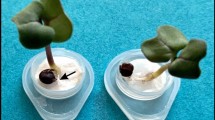Abstract
A report that fluorescent staining can be used as an indicator of the pathogenicity of populations of resting spores of Plasmodiophora brassicae was investigated. In a series of three experiments, resting spores of P. brassicae were subjected to stress induced by physical, ionic and disinfectant treatments. A fluorescent staining technique was used to directly assess the pathogenic activity of the inoculum and subsequent expression of disease symptoms was observed on inoculated broccoli and Chinese cabbage seedlings. Physical treatments, dry heat, pressurised heat and UV light induced gross changes in the pathogenic activity of the spores which was correlated (r=0.80) with reductions in the severity of symptoms of disease. Ionic treatments resulted in only relatively small reductions in pathogenic activity and there was no correlation between pathogenic activity and eventual symptom expression. None of the nine commercially available disinfectants completely eliminated clubroot. Most were ineffective. There was no correlation between pathogenic activity and the development of disease symptoms in host plants following treatment of the resting spores with the disinfectants. These results indicate that fluorescent staining may be used to predict gross changes in symptom expression, but further work is required to determine whether direct (fluorescent stain) or indirect (plant bait) methods provide a better estimate of resting spore pathogenicity for routine assessment of laboratory trials. Both methods had inherent errors, and where differences between treatment effects were small, no relationship was found between the two measures.
Similar content being viewed by others
References
Buczacki ST, Moxham SE (1983) Structure of the resting spore wall of Plasmodiophora brassicae revealed by electron microscopy and chemical digestion. Transactions of the British Mycological Society 81, 221–231.
Buczacki ST, Ockendon JG, Freeman GH (1978) An analysis of some effects of light and soil temperature on clubroot disease. Annals of Applied Biology 88, 229–238.
Colhoun J (1958) ‘Club root disease of crucifers caused by Plasm odiophora brassicae Woron. Phytopathological Paper No. 3.’ (Commonwealth Mycological Institute: Kew)
Dixon GR (1976) Methods used in Western Europe and the U.S.A. for testing Brassica seedling resistance to club root (Plasmodiophora brassicae). Plant Pathology 25, 129–134.
Dobson R, Gabrielson RL, Baker AS (1982) Soil water matric potential requirements for root-hair and cortical infection of Chinese cabbage by Plasm odiophora brassicae. Phytopathology 72, 1598–1600.
Faggian R, Donald C, Porter IJ, Lawrie AC (1999) Epidemiology of recent clubroot outbreaks using PCR to trace sources of inoculum. In ‘Proceedings of the Australasian plant pathology society 12th Biennial Conference, Canberra, Australia’. (Abstract) p. 342.
Gibbs JG (1931) Club-root in cruciferous crops. New Zealand Journal of Agriculture 42, 1–17.
Myers DF, Campbell RN (1985) Lime and the control of clubroot of crucifers: Effects of pH, calcium, magnesium, and their interactions. Phytopathology 75, 670–673.
Naiki T, Kageyama K, Ikegami H (1978) The relation of spore density of Plasm odiophora brassicae Wor. to the root hair infection and club formation in Chinese cabbage (studies on the clubroot of cruciferous plant II). Annals of the Phytopathological Society of Japan 44, 432–439.
Parsons S (2000) ‘The relationship between Polymerase Chain Reaction amplification and the viability of Plasm odiophora brassicae Woronin resting spores.’ Honours Thesis, Department of Applied Biology and Biotechnology, RMIT University, Melbourne.
Payne RW, Lane PW, Ainsley AE, Bicknell KE, Digby PGN, Harding SA, Leech PK, Simpson HR, Todd AD, Verrier PJ, White RP (1987) ‘Genstat 5 reference manual.’ (Oxford University Press: Oxford)
Russell AD, Ahonkhai I, Rogers DT (1979) A review. Microbiological applications of the inactivation of antibiotics and other antimicrobial agents. Journal of Applied Bacteriology 46, 207–245.
Sherf AF, Chupp C (1986) ‘Vegetable diseases and their control.’ (Wiley: New York)
Takahashi K (1991) Correlation between fluorescent staining reaction and germination in resting spores of Plasmodiophora brassicae. Annals of the Phytopathological Society of Japan 57, 160–164.
Takahashi K, Yamaguchi T (1988) A method for assessing the pathogenic activity of resting spores of Plasmodiophora brassicae by fluorescence microscopy. Annals of the Phytopathological Society of Japan 54, 466–475.
Takahashi K, Yamaguchi T (1989) Assessment of pathogenicity of resting spores of Plasmodiophora brassicae in soil by fluorescence microscopy. Annals of the Phytopathological Society of Japan 55, 621–628.
Thuma BA, Rowe RC, Madden LV (1983) Relationships of soil temperature and moisture to clubroot (Plasmodiophora brassicae) severity on radish in organic soil. Plant Disease 67, 758–762.
Voorrips RE (1996) A one-hit model for the infection of clubroot-susceptible cabbage (Brassica oleracea var. capitata) by Plasmodiophora brassicae at various inoculum densities. European Journal of Plant Pathology 102, 109–114.
Voorrips RE, Visser DL (1993) Examination of resistance to clubroot in accessions of Brassica oleracea using a glasshouse seedling test. Netherlands Journal of Plant Pathology 99, 269–276.
Author information
Authors and Affiliations
Corresponding author
Rights and permissions
About this article
Cite this article
Donald, E.C., Lawrence, J.M. & Porter, J. Evaluation of a fluorescent staining technique as an indicator of pathogenicity of resting spores of Plasmodiophora brassicae . Australasian Plant Pathology 31, 373–379 (2002). https://doi.org/10.1071/AP02042
Received:
Accepted:
Issue Date:
DOI: https://doi.org/10.1071/AP02042




